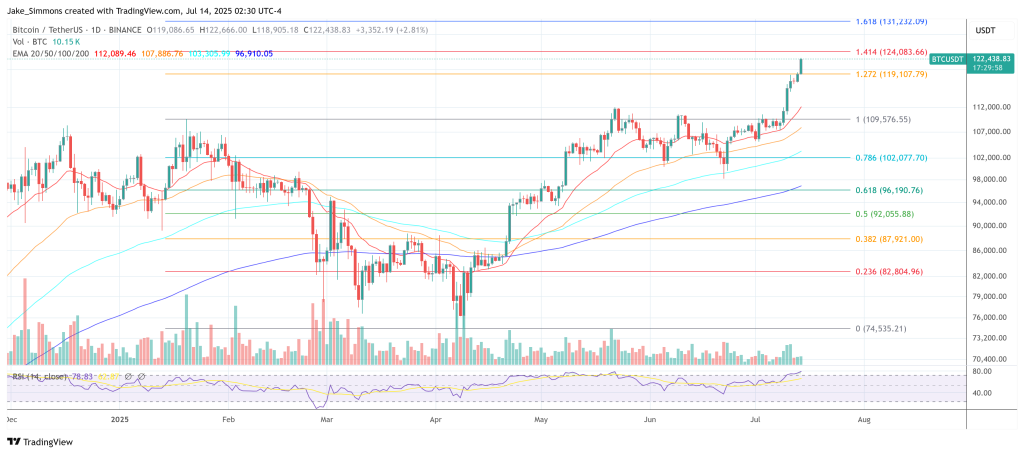Motive to belief

Strict editorial coverage that focuses on accuracy, relevance, and impartiality
Created by trade specialists and meticulously reviewed
The best requirements in reporting and publishing
Strict editorial coverage that focuses on accuracy, relevance, and impartiality
Morbi pretium leo et nisl aliquam mollis. Quisque arcu lorem, ultricies quis pellentesque nec, ullamcorper eu odio.
Bitcoin punched by means of a contemporary file above $122,000 on the morning of 14 July, extending its month-long rally to greater than 16 %. In opposition to that backdrop, Charles Edwards—the founder and chief govt of digital-asset hedge fund Capriole Investments—argues that the market is just “within the early phases” of a much wider liquidity-driven growth that might dominate the remainder of 2025 and past.
The Bitcoin Liquidity Supercycle
Within the newest Capriole publication, Edwards contends that “cash and liquidity supplied the backdrop for capital flows, and Bitcoin Treasury Corporations are the funnel.” He dismisses the concept the previous fortnight’s $20,000 advance was a technical accident, pointing as an alternative to deep macro currents which have been constructing for months.
“The most important Bitcoin rallies happen when the market is internet brief the USD,” he writes, pointing to Capriole’s proprietary “USD Positioning” gauge, which aggregates futures information throughout main currencies. The metric has been “deeply detrimental” since early summer time, signalling that international traders are decisively betting in opposition to the greenback and in favour of exhausting belongings.
Associated Studying
One other pillar is credit score. BBB-rated corporate-bond spreads have been grinding tighter for the reason that spring, a traditional risk-on sign in conventional markets that, since 2020, has mapped virtually tick-for-tick onto main Bitcoin up-moves. “Extra proof,” Edwards notes, “that Bitcoin is a tradfi asset.”
Maybe the strongest tail-wind, nonetheless, is uncooked cash progress. International M3 has been increasing at an annualised 9 % clip—an traditionally excessive fee that Capriole says final coincided with common 12-month Bitcoin returns of roughly 460 %. Edwards cautions that, as a multi-trillion-dollar asset at the moment, Bitcoin is unlikely to repeat that magnitude, “however it wouldn’t be shocking to see one thing very substantial from right here.”
Capriole’s framework additionally attracts on an historic lead-lag relationship between gold and Bitcoin. When bullion enters a significant breakout, Bitcoin has tended to observe three to 4 months later. Gold’s early-2025 surge—and its outperformance versus international equities—due to this fact provided “robust assist for the present market’s diminishing demand for fiat cash and favour of exhausting cash,” Edwards argues. Since Capriole flagged gold’s transfer in April, Bitcoin has risen 28 %.
Equities, too, are providing inexperienced lights. The New York Inventory Trade advance–decline line broke to new highs final week, whereas Capriole’s “Fairness Premium” indicator reset to zero in late Might—each traditionally in line with multi-month stretches of increasing threat urge for food.
All of these information factors feed into the agency’s flagship Bitcoin Macro Index, a composite of dozens of public and proprietary variables that Capriole makes use of to form buying and selling exposures in its fund. The index “remains to be in robust optimistic progress territory,” Edwards stories, even after the coin’s newest vertical transfer. That means the underlying drivers—liquidity, threat sentiment and on-chain exercise—“stay intact.”
The Bitcoin Treasury-Firm Flywheel
But maybe essentially the most putting piece of the puzzle lies outdoors pure macro. Edwards highlights the emergence of Bitcoin Treasury Corporations (TCs)—company automobiles that elevate fiat capital in fairness or debt markets after which deploy it into spot BTC—as the brand new “major bubble dynamic of this cycle.”
Associated Studying
Quarterly inflows into TCs reached $15 billion in Q2, and Capriole counts a minimum of 145 such corporations now pursuing the technique. With their market capitalisations inflated by paper beneficial properties on balance-sheet cash, they’ll faucet ever-larger funding rounds—a reflexive loop that Edwards believes “will possible assist add over $1 trillion to Bitcoin’s market cap over the subsequent yr.”
He rejects the notion that this quantities to unhealthy centralisation: “If Bitcoin is to at some point change into base cash, it must scale to tens of trillions to flatten volatility. The one method that occurs is mass acquisition like we’re seeing at the moment.”
Edwards stresses that his evaluation sits on a months-long horizon. “When Bitcoin sees enormous rallies there are at all times robust pullbacks and native overheating,” he concedes, including that the publication intentionally sidelines short-term on-chain froth to deal with the “larger image and driving elements for the subsequent six months.”
Nonetheless, with central-bank liquidity considerable, the greenback crowded brief, credit score stress muted and a structurally new pool of company patrons stepping in, Capriole’s conclusion is unambiguous: the liquidity faucet is large open, and the Bitcoin supercycle it feeds has solely simply begun.
“Whereas at the moment’s early adopters could also be seen as speculators, it is going to be very apparent in hindsight. After the Treasury firm wave is the Authorities treasury wave (subsequent cycle). We’re merely using the adoption curve which requires trillions of {dollars} to stream in to Bitcoin from the entities which have it in an effort to obtain scale,” Edwards concludes.
At press time, BTC traded at $122,438.

Featured picture created with DALL.E, chart from TradingView.com




